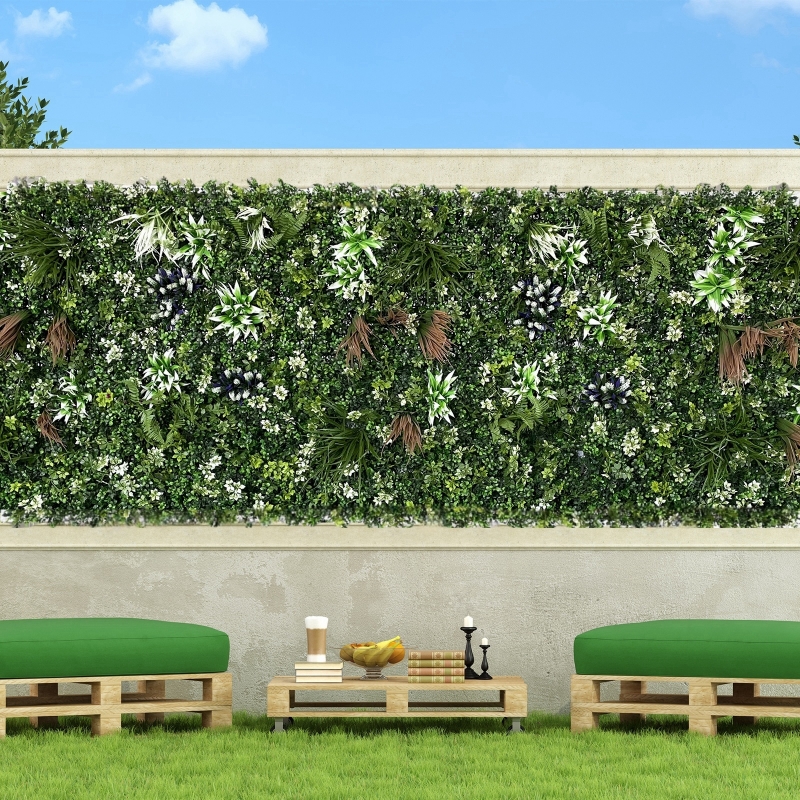Vertical gardens, due to their closed structure and dense plants, are prone to poor ventilation, which can lead to problems such as excessive humidity and the breeding of diseases. The air circulation needs to be optimized through the combination of active and passive design. The following are the ventilation treatment strategies for each module:
Core objective
Reduce the moisture of the substrate and the plant surface to decrease fungal diseases (such as powdery mildew and gray mold).
Promote carbon dioxide replenishment and enhance the efficiency of photosynthesis.
Avoid high-temperature heat accumulation and maintain an appropriate temperature for plant growth (20-30℃).
Main challenges
The vertical structure hinders the flow of natural wind, creating dead corners of the "wind tunnel effect".
Overlapping plant leaves reduces the efficiency of local air exchange.
During the hot summer, insufficient ventilation can easily lead to the obstruction of plant transpiration, resulting in wilting.
Natural ventilation optimization
Structural opening design
Reserve ventilation openings at the top, bottom and sides of the vertical garden frame to form a "chimney effect".
Example: If the vertical garden is 3 meters high, the area of the top ventilation opening should be no less than 10% of the bottom area to promote the upward movement and discharge of hot air.
Adjustment of plant layout
Arrange shade-tolerant plants in the inner layer and wind-loving plants (such as mint and lavender) in the outer layer to form air flow guidance.
Avoid overly dense plants. Keep the leaf spacing at 5 to 10 centimeters to ensure air penetration.
2. Mechanical ventilation assistance
Application of Small Fans
Install low-noise axial flow fans at the back or side of the vertical garden, with the wind speed controlled at 0.5-1.5 meters per second, to prevent strong winds from damaging the plants.
Example: One fan is configured for every 10 square meters of vertical garden, and the operating time is set to 2 hours during the daily high-temperature period (10:00-15:00).
The combination of positive pressure and negative pressure
Positive pressure ventilation: Fans supply air into the garden, pushing the air out from the top.
Negative pressure ventilation: The fan draws air from the garden to accelerate the discharge of hot and humid air.
Positive pressure ventilation is adopted in summer when the temperature is high, and negative pressure ventilation in winter when the temperature is low to prevent cold air from blowing directly on the plants.
Avoid the contradiction of humidity
The ventilation outlets are staggered from the irrigation pipes to prevent irrigation water from entering the fans or blocking the ventilation outlets.
Example: Irrigation pipes are laid along the bottom of the vertical garden, and ventilation openings are set in the middle and above areas.
Dynamic adjustment strategy
Install temperature and humidity sensors. When the humidity exceeds 80% or the temperature exceeds 30℃, the fan will be automatically started.
When the humidity is high at night, the fan will be turned off one hour later to ensure that the surface of the substrate is dry.
Enclosed space vertical gardens (such as indoor and underground garages)
All-mechanical ventilation system
The circulating fan is combined with the fresh air system, and the air change rate per hour is no less than 3 times.
For example, an indoor vertical garden needs to be equipped with an activated carbon filter to purify the ventilated air and reduce odors.
Airflow simulation design
Through CFD (Computational Fluid Dynamics) simulation, the position and wind speed of the wind turbine are optimized to avoid local airflow dead corners.
2. Vertical gardens on the exterior walls of high-rise buildings
Wind-resistant structure reinforcement
Adjustable louvers are installed at the ventilation openings, which will automatically close in windy weather to prevent strong winds from damaging plants.
Example: The tilt Angle of the blinds is designed to be 30°-45°, taking into account both ventilation and wind prevention.
Vertical airflow guidance
Deflector plates are set up on the exterior walls of the building to guide the natural wind to the vertical garden area and reduce the reliance on mechanical ventilation.
Regular inspection
Clean the ventilation outlets and fan blades every month to prevent dust accumulation from affecting efficiency.
Check the lubrication condition of the fan bearings every quarter to ensure smooth operation.
Fault handling
When the fan stops, first check the power supply and controller, and then inspect the motor and blades.
Poor ventilation: Check if the ventilation openings are blocked by plants or adjust the Angle of the fan.
Plant selection
Give priority to plants with strong wind resistance and sparse leaves (such as hanging petunias and Sedum lineare) to reduce air resistance.
Matrix improvement
Add perlite or vermiculite to the substrate to enhance air permeability and assist in ventilation.
Biological control
Release predatory mites or ladybugs to control pests caused by poor ventilation (such as red spiders and aphids).
Through the above ventilation treatment solutions, 3D artificial vertical gardens can achieve efficient air circulation, reduce the risk of diseases, and at the same time improve the quality of plant growth and the sustainability of the landscape. The design should be combined with the site conditions and plant requirements, and the ventilation strategy should be dynamically adjusted to ensure the long-term stable operation of the system.

Contact: Amy
Phone: 86-15311787313
E-mail: info@foszmac.com
Whatsapp:86-15311787313
Add: Fengtai District, Dacheng Road, No.24 Building, Room 203, Beijing, China